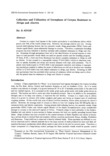Collection and Utilization of Germplasm of Cowpea Resistant to Striga and Alectra
JIRCAS international symposium series
| ISSN | 13406108 |
|---|---|
| 書誌レコードID(総合目録DB) | AA1100908X |

本文フルテキスト
intlsymp-2_135-143.pdf397.54 KB
Cowpea is a major food legume in the tropics particularly in sub-Saharan Africa which grows over 75% of the world cowpea area. However, the average yield is very low. Among several yield-reducing factors, the two parasitic weeds, Striga gesnerioides (Wild.) Vatke and
Alectra vogelii Benth. cause substantial damage to cowpea. Therefore, a systematic breeding program has been initiated to develop varieties with combined resistance to Striga and Alectra. Screening through germplasm lines led to the identification of several sources of resistance to both parasitic weeds which are used for genetic studies and the breeding program. Of these, B 301, a land race from Botswana has shown complete resistance to Striga as well as Alectra. It was crossed to a susceptible variety IT 84 S-2246-4 which is otherwise resistant to aphids, bruchids and thrips and several diseases with high yield potential. The F1 plants were backcrossed to IT 84 S-2246-4 and systematic selection and testing of segregating populations enabled to define the mode of inheritance as well as to develop new varieties similar to IT 84 S-2246-4 but with added resistance to Striga, and Alectra. Screening of 1600 new germplasm lines has provided other sources of resistance which are being used to diversify the genetic base for resistance to Striga and Alectra in cowpea.
Alectra vogelii Benth. cause substantial damage to cowpea. Therefore, a systematic breeding program has been initiated to develop varieties with combined resistance to Striga and Alectra. Screening through germplasm lines led to the identification of several sources of resistance to both parasitic weeds which are used for genetic studies and the breeding program. Of these, B 301, a land race from Botswana has shown complete resistance to Striga as well as Alectra. It was crossed to a susceptible variety IT 84 S-2246-4 which is otherwise resistant to aphids, bruchids and thrips and several diseases with high yield potential. The F1 plants were backcrossed to IT 84 S-2246-4 and systematic selection and testing of segregating populations enabled to define the mode of inheritance as well as to develop new varieties similar to IT 84 S-2246-4 but with added resistance to Striga, and Alectra. Screening of 1600 new germplasm lines has provided other sources of resistance which are being used to diversify the genetic base for resistance to Striga and Alectra in cowpea.
| 作成者 | Bir. B. SINGH |
|---|---|
| 公開者 | Japan International Research Center for Agricultural Sciences |
| オンライン掲載日 | |
| 号 | 2 |
| 開始ページ | 135 |
| 終了ページ | 143 |
| 言語 | eng |
